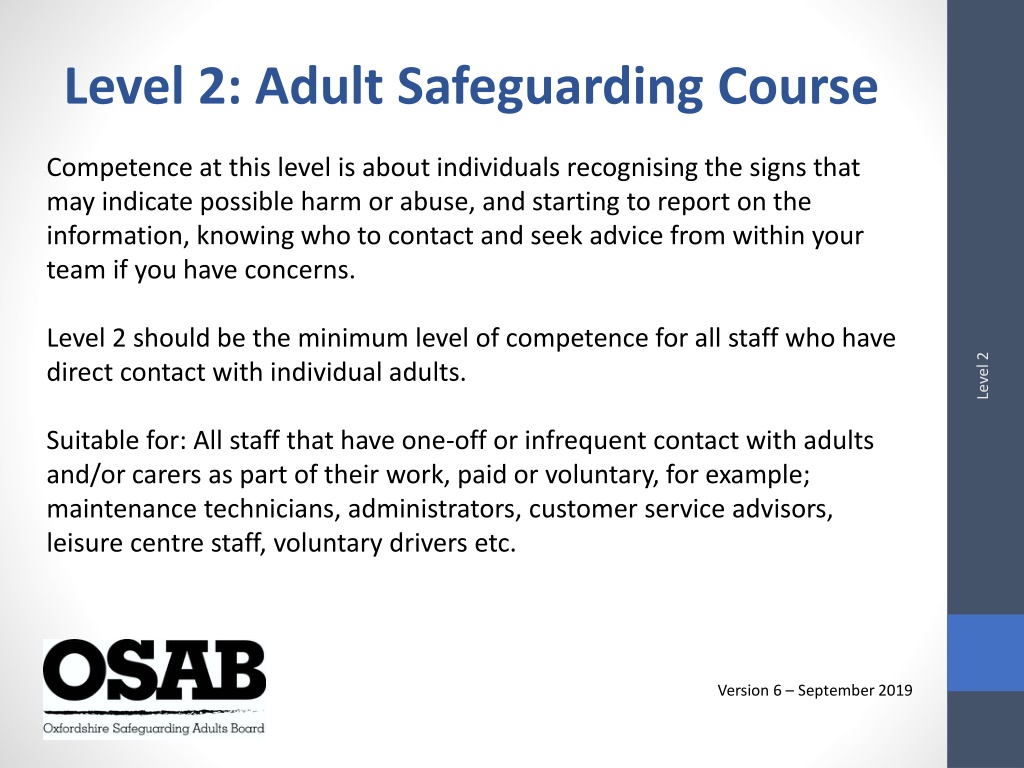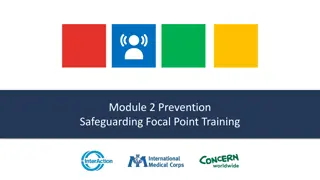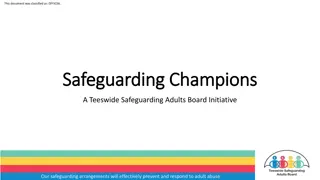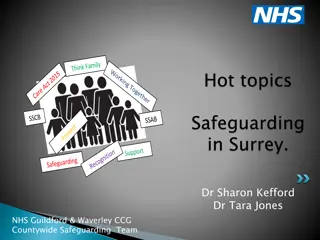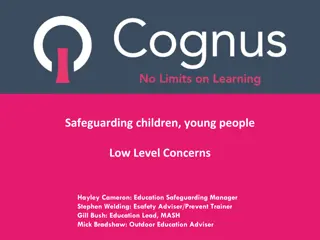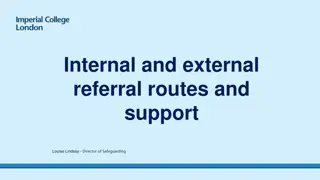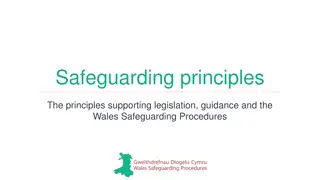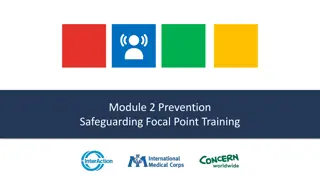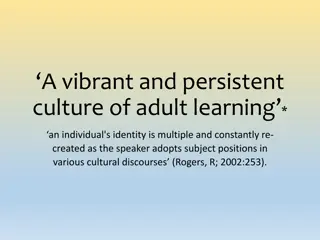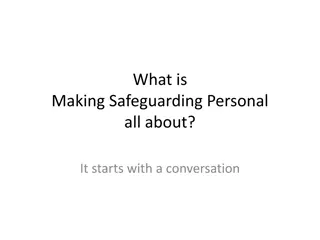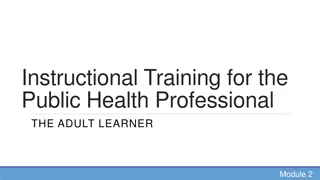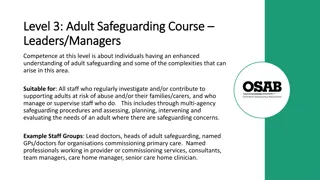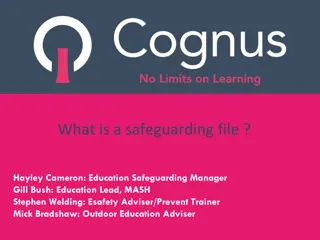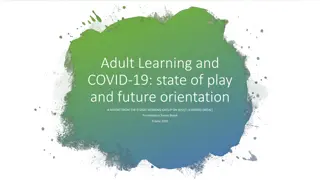Adult Safeguarding Course Level 2 Overview
This Adult Safeguarding Course Level 2 provides competence for individuals to recognize signs of possible harm or abuse in adults. Participants learn to report information, contact appropriate individuals within their team, and seek advice. Suitable for staff with one-off or infrequent contact with adults. The course aims to enable the identification and referral of adults at risk of abuse, emphasizing the importance of safeguarding principles and maintaining confidentiality.
Download Presentation

Please find below an Image/Link to download the presentation.
The content on the website is provided AS IS for your information and personal use only. It may not be sold, licensed, or shared on other websites without obtaining consent from the author.If you encounter any issues during the download, it is possible that the publisher has removed the file from their server.
You are allowed to download the files provided on this website for personal or commercial use, subject to the condition that they are used lawfully. All files are the property of their respective owners.
The content on the website is provided AS IS for your information and personal use only. It may not be sold, licensed, or shared on other websites without obtaining consent from the author.
E N D
Presentation Transcript
Level 2: Adult Safeguarding Course Competence at this level is about individuals recognising the signs that may indicate possible harm or abuse, and starting to report on the information, knowing who to contact and seek advice from within your team if you have concerns. Level 2 should be the minimum level of competence for all staff who have direct contact with individual adults. Level 2 Suitable for: All staff that have one-off or infrequent contact with adults and/or carers as part of their work, paid or voluntary, for example; maintenance technicians, administrators, customer service advisors, leisure centre staff, voluntary drivers etc. Version 6 September 2019
Welcome and Housekeeping Level 2 Exits & Fire Procedures Course Timings & Breaks Course materials Mobile Phones Toilets 2
Our Training Agreement Each member has a valid contribution to make. Give and receive constructive feedback. Multi-agency issues may be discussed but should be done so professionally and with respect towards all course delegates. Level 2 Support the principle of confidentiality. Use this session to network and share good practice. 3
Aim To be able to identify when adults are at risk of abuse or are being abused within their usual environments and how to refer. To know who to contact if they have concerns and who to seek advice from across the partnership. Objectives Demonstrate an ability to recognise and describe a safeguarding issue to the most appropriate professional (IE line manager) or local safeguarding team. Level 2 Demonstrate and document concerns. Demonstrate an understanding of the Mental Capacity principles. 4 Demonstrate an ability to refer appropriately.
Introductions and Networking Level 2 5
How does adult safeguarding differ from children s safeguarding? Level 2 6
What does safeguarding mean? Protecting an adult s right to live in safety, free from abuse and neglect. It is about people and organisations working together to prevent and stop, both the risk and experience of abuse and neglect. Level 2 Safeguarding is everyone s responsibility. 7
What is abuse? Where can it take place? Who can be an abuser? Abuse is when someone causes us harm or distress. It can be something that happens only once. It can be something that happens more than once. It can be unintentional. It can be a deliberate act. It can sometimes be a crime. Abuse can happen anywhere. It can be undertaken by anyone. Level 2 8
Why were here: Legal framework Level 2 9
Who does adult safeguarding apply to? Adults (age 18+) who: (a) has needs for care and support (whether or not the authority is meeting any of those needs), Level 2 (b) is experiencing, or is at risk of, abuse or neglect, and (c) as a result of those needs is unable to protect himself or herself against the abuse or neglect or the risk of it. 10
Safeguarding the wider population Support may be available from: Police, domestic abuse services, homeless services, fire service, the National Referral Mechanism for victims of modern slavery, community and support groups, other social services teams, housing providers, trading standards. Level 2 Guidance document https://www.osab.co.uk/wp-content/uploads/Procedure-for-adults- who-dont-engage-v2.pdf 11
Categories of Abuse Level 2 12
What To Look Out For Level 2 13
Level 2 14
Case Study Bengt has contacted the Customer Service Team to complain about the noise coming from his neighbour s property at all hours of the night He informs the Customer Service Advisor that his neighbour Paulo is in his 80 s, doesn t go out much, and he does not usually hear any noise at all, but over the past few weeks has heard music, loud talking and banging coming from the property at night. Level 2 What are your initial thoughts about this situation? What questions could you ask? 15
Six Principles - Safeguarding Adults Empowerment Protection Prevention Proportionality Partnership Accountability Level 2 16
Communication I m concerned about you because Ask open questions, do not lead Ask the person what is happening to them Ask the person what, if anything, they would like to change Ask the person if they agree to you sharing the information Level 2 17
Decision Making in Practice Level 2 18
Independent Advocates IMCA - Independent Mental Capacity Act Advocate IMHA - Independent Mental Health Act Advocate Level 2 ICAA - Independent Care Act Advocate POhWER www.pohwer.net/oxfordshire 19
What To Do With A Safeguarding Issue Level 2 20
Record Keeping 1. Record of concern forms for all staff to use e.g. incident reports 2. Recording of actions and outcomes 3. Accurate factual information Level 2 4. Date and time 5. Name of staff member signed and dated 6. Record any questions you/or your staff member asked 21
Safeguarding Adults Service As a worker/volunteer - refer via online form on OSAB Website: http://www.osab.co.uk/public/reporting-concerns/ and click on Professional Safeguarding Alerter form , alternatively, call the Consultation Line 01865 328232 to have initial discussion Referrer and the person who the concern is about are contacted (where possible) to gather more information. Level 2 Decision made whether to close the concern or to put it forward to further enquiry (Section 42 of the Care Act 2014). Both the referrer and the person who is being abused will be informed of what is going on as far as possible. 22
Case Studies Read the case studies What are your initial impressions? Any potential signs of abuse? Level 2 If you were aware of this situation, would you report it? If yes, who to and how? 23
Summary Talk with the adult. Is there anything you can help with immediately to reduce any risks? Refer to Threshold of Needs Matrix. Level 2 Any concerns should be reported, either to Line Manager, Safeguarding Lead and/or Safeguarding Adults Team. Document facts clearly and concisely. Be prepared to contribute to any safeguarding enquiry which may take place. 24
